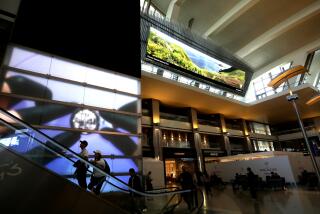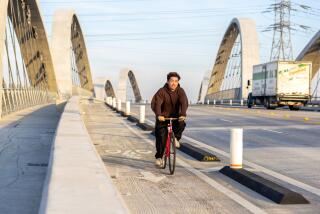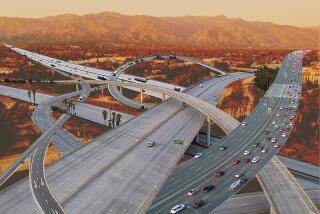What gridlock?
SPRAWL IS NOT the worst thing that ever happened to the nation’s cities. In fact, by many measures, it’s been beneficial. Despite the cliche among some academics and intellectuals that sprawl leads to incoherent, unattractive, traffic-clogged cities, the reality is that it has benefited many people over many years. Most Americans today, including the vast majority of suburbanites, are happy where they live, work and play.
So what explains the great crusade against sprawl? How could a recent book on urban planning have opened with the unqualified -- and patently ludicrous -- assertion that “sprawl is America’s most lethal disease”? How has the campaign against sprawl -- and the American car culture that goes with it -- become a potent political force across the country?
I would argue that to a great extent, worries about sprawl and traffic have developed not because our situation is so bad but precisely because it is so good. In good economic times, expectations tend to run ahead of what is possible. And soaring expectations rather than actual problems are, I believe, responsible for a good deal of our contemporary discontent.
A good example of this is the thunderous din of complaints about traffic in Los Angeles. From one perspective, this reaction is simply bizarre. Even when speeds on the freeway decline to 20 mph, drivers throughout the Los Angeles area move more quickly than they do by car or public transportation at the center of almost any large, older city in Europe or the United States.
Clearly the problem is not that congestion is objectively worse in Los Angeles. It is that the highway builders of the 1950s and 1960s were so successful in building their way out of congestion that people became used to driving across the entire metropolitan area at a mile a minute and made choices about where they lived and worked based on that reality.
When it comes to automobile travel, Los Angeles, perhaps more than almost any other large city in the world, suffers from a deflation of greatly raised expectations. After all, the residents of Paris, New York or Tokyo never even entertained the possibility that they could drive through the center of the city at 60 mph.
In recent years, it is true, L.A.’s congestion has gotten worse. But that is actually less the fault of sprawl than it is the result of things that have been done or not done because of misconceptions about sprawl. Consider the history. Today’s solid anti-sprawl and anti-highway consensus first began to emerge in the 1960s, in part as a reaction against postwar urban renewal and highway construction. But rather than confine themselves to the quite real and indisputable damage that the intense campaign of freeway construction of those years did to existing urban neighborhoods, the anti-auto activists pushed further and claimed that the entire program hurt central cities by encouraging suburban growth.
Even more dramatically, they argued that constructing new roads was useless as a way to reduce congestion because, they said, the highways themselves “induced” traffic by generating new demand. Their most convincing proof for this assertion was the observation that new highways quickly filled with automobiles. From this they derived the notion that any new highway would simply fill itself up as soon as it was built, producing no net benefit. Hence, the widely accepted aphorism: “You can’t build your way out of congestion.”
The only way to break the vicious cycle of new roads, more traffic and increasing sprawl, the anti-auto forces claimed, was to stop building roads and create more mass transit. This would, according to their logic, turn the vicious cycle on its head, creating instead a virtuous cycle in which more people riding on urban mass transit would create more demand for work and housing within the city in areas convenient to transit stops.
This is, of course, the logic that has undergirded a great deal of public policy in Los Angeles and many places across the country in the last several decades. And it has led to the expenditure of billions of dollars on new transit systems, such as the new light-rail lines and subway in Los Angeles (as well as Mayor Antonio Villaraigosa’s proposal to extend the subway still farther down Wilshire Boulevard).
However, despite this expenditure, transit’s share of total trips has fallen and traffic has continued to get worse in almost every market in the country. In the L.A. region, for example, mass transit, which accounted for an extremely small 1.94% of trips in 1983, dropped to only 1.64% in 2003, according to figures compiled by transportation consultant Wendell Cox.
Why has this happened? I suggest that it is because so many people are locked into unrealistic assumptions about the way transit worked in the past or could work in the future.
First of all, and contrary to much popular opinion, it is clear that L.A.’s highways were not intended to hurt the central city, as many have suggested, nor were they part of a devious plot to eliminate alternatives to cars.
The fact is that Los Angeles had a terrible traffic problem in the 1920s and ‘30s. Many downtown business owners felt that this congestion was threatening their very existence at a time when investment downtown had lagged and there was fierce competition from outlying centers such as the Miracle Mile or Hollywood.
Not surprisingly, downtown businessmen were highly enthusiastic about plans for a massive superhighway system to bring people downtown more efficiently. Starting in the 1940s, the Los Angeles area embarked on one of the most ambitious programs of highway building in American history.
This campaign was largely successful. Anyone who is old enough to have driven in L.A. or in most other U.S. cities in the 1960s or ‘70s can testify to the sense of liberation that accompanied the completion of the new roads. Suddenly it was possible, in a matter of minutes, to make trips that had previously taken hours. People in Santa Monica soon thought nothing of accepting dinner invitations in Pasadena. This increase in mobility meant greater choice in jobs, housing and recreational outlets. This, in turn, helped fuel an enormous amount of growth and prosperity in Southern California.
Unfortunately, this enhanced mobility has been greatly eroded since the 1970s, as population and density have increased without a corresponding development in the highway network. The L.A. region, once at the forefront of freeway development, now falls toward the bottom of the list of cities in the number of freeway lane miles per capita.
As the population has grown, as families have become more affluent and as more women have entered the workforce, there has been a major increase in car ownership and driving -- and a mounting demand for mobility more generally. The pace of growth in the size and wealth of the Los Angeles area would clearly have put a strain on any transportation system.
But mobility has been impaired much more than it needed to be. In part this can be attributed to the way the sprawl debates of the last few decades have pitted citizen against citizen by suggesting that the choice is between public versus private transportation and the automobile versus the railroad. What this has done has been to weaken the consensus for funding for all kinds of transportation -- public and private, highway and rail. This, in turn, has hurt mobility, exacerbated traffic problems and eroded the global competitiveness of Los Angeles.
Given the great success of the anti-highway lobby in arguing its cause, it is not surprising that during the recent decades of tax cutting and tight budgets, there has been a marked lack of taxpayer support for building adequate new roads and increasing capacity on existing roads. Unhappily, the fixation on sprawl has also detracted attention from the scenarios that might, over the long run, help build effective new public transportation systems. It is quite likely that this will need to involve the replacement of both the train and the gasoline-fueled automobile in the years ahead. Both are, after all, 19th century means of transportation, and very inefficient ones at that.
There is no technical reason that we couldn’t have, not too far in the future, personal rapid transportation capsules running both on rails and rubber wheels, using alternative fuel sources and operating either on their own over short distances or linked together for longer distances on guideways that would allow speeds of hundreds of miles per hour. Such a system could vastly increase the capacity of existing right of way and go far toward reducing pollution.
Because cities are so dynamic, it is difficult to know whether our future urban areas will be lower or higher in density than today’s. In either case, new modes of transportation that combine the adaptability and personal comfort of the auto with the efficiency of the train or bus are more likely, in the long run, to satisfy the needs of most Americans than forcing everyone back into high-density cities so they can ride trains.
We can do it, and we can enhance mobility for everyone. But only if we can put aside for a while the old and not-terribly-helpful battles over sprawl.






